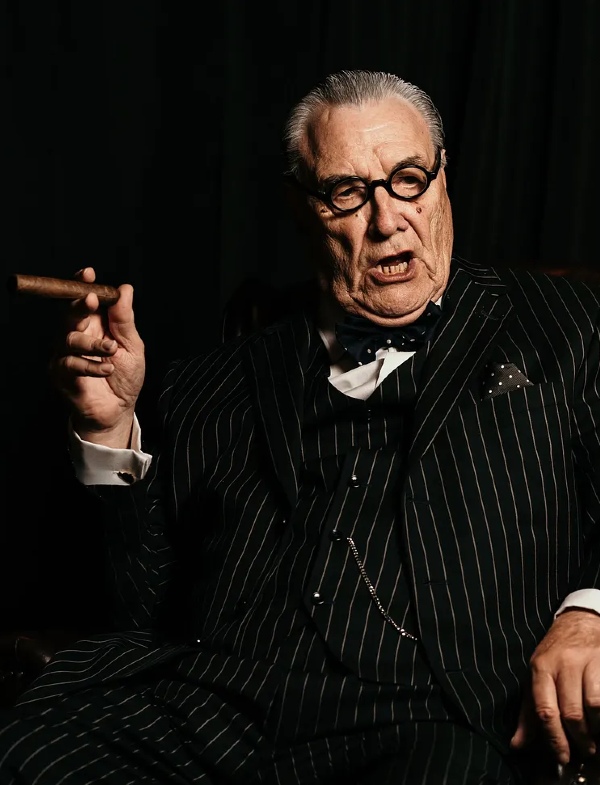At the Calderwood Pavilion on October 7, 2025, the stage is set with restraint and intention: a spotlight revealing framed portraits of Churchill’s parents, a simple chair, and a side table holding the familiar Homburg hat, cigar, and bottle of whiskey. Nothing is excessive; everything is essential.
Then he walks in—Churchill himself. David Payne enters with a polite apology for being late, instantly drawing the audience into his world. From that first moment, he doesn’t simply portray a historical figure; he creates a living world, one in which we are subtly cast as co-actors.
Watching David Payne inhabit Winston Churchill is to be part of an important time in our history. Set in 1963 at Blenheim Palace, during a dinner hosted by the Oxford American Society, Churchill gives an informal talk, and we, the audience, are drawn into that gathering. This directorial instinct—to fold us into the drama—transforms spectatorship into participation, making Churchill’s era feel startlingly present.
Payne, as Churchill, recounts the events and people who influenced his life. What gives this work its force is Payne’s grasp of Churchill’s cadence, humor, and physicality, clearly springing from deep reading and visual study. He seems to hold an internal, human truth: that Churchill’s public grandeur was built on private vulnerability and unrelenting conviction. Through that insight, the monumental statesman becomes accessible; his wit lands naturally, as part of the conversation.
By evening’s end, we feel we have not only seen Churchill, but met him, and, perhaps unexpectedly, met ourselves as players in the theatre of history.
Q & A with David Payne
Following his extraordinary performance, Global Indian Artist (GIA) reached out to David Payne with a few questions. What follows is an intimate glimpse into his process behind portraying Winston Churchill.
Q1. I am curious about your creative process. Did you immerse yourself in Churchill’s world by reading extensively and watching visual footage to embody his mannerisms and voice? Your performance felt so seamlessly inhabited that it became difficult to distinguish between you and Churchill himself.
David Payne:
Yes, I did immerse myself in many areas of research, but with a focus on those aspects of his life that reveal what made him the man he was—what made him ‘tick.’ I explored his early years, his relationships with his parents, what shaped his humor, how he overcame a childhood speech impediment and how that journey enabled him to become a great orator. Of course, I watched visual and audio footage, not just of him but of those who knew him, and discovered many other factors that enabled me—as you say—to ‘inhabit’ the man. If you can’t inhabit a character, it’s almost impossible to achieve authenticity. My objective has always been to portray someone like Churchill in a way that enables the audience to forget the actor and embrace the character.
Q2. What was your anchor point—the first impulse or key insight you held onto as you began shaping this role?
David Payne:
The anchor point for me was always not so much to dwell on what he achieved, but what made him the man he was.
Q3. What were your challenges in personifying such a larger-than-life presence in world history while still making him human and immediate to us?
David Payne:
For me, the primary requirement was to immerse myself in the phenomenon that was Churchill—but a phenomenon who was a human being, experiencing the same ups and downs we all contend with. Sometimes when someone is as famous as Churchill, the tendency is to assume they are super-human, when in reality, they are subject to the same challenges and emotions all humans face. Churchill was no exception.
In David Payne’s portrayal, Churchill steps out of history’s portrait frame and into the immediacy of human presence. What remains with us is not just the echo of great speeches, but the reminder that conviction, vulnerability, humor, and doubt all coexist within those who shape history.

